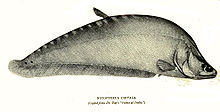- Chitala chitala
-
Clown knifefish 
Conservation status Scientific classification Kingdom: Animalia Phylum: Chordata Class: Actinopterygii Order: Osteoglossiformes Family: Notopteridae Genus: Chitala Species: C. chitala Binomial name Chitala chitala
F. Hamilton, 1822Chitala chitala or clown knifefish (Bengali: চিতল)(Tamil: அம்பட்டன்வாளை, சொட்டைவாளை or அம்புட்டன் வாழ) is a fish of the genus Chitala found in India and other countries in Southeast Asia. Main foods are smaller fishes and fish pellets (in aquarium). They have been introduced to some areas of the United States. As an aquarium fish, they are popular in the United States and have likely been released from aquarium environments. South Florida anglers have been known to catch the fish when attempting to bass fish. They are also considered delicacies in other countries especially due to their immense size (see below).
Physical description
They are called "clown" because of the spots on their sides which multiply as they age. The royal clown knife fish (mostly seen in aquarium) has more spots and is more attractive. They are also called "featherbacks" due to the small feather-like fin on their backs. They grow up to 3 feet in the wild and about 18-19 inches in aquarium (depending on the size of the aquarium).
In an aquarium
They can be kept rather easily in the aquarium. They are normally kept in tanks ranging from 10-40 gallons (as hatchlings) and 55 gallons and up (juveniles and adults). For a fully grown clown knife fish, the best recommended size tank would be at least 75 gallons or up. They can be kept together as hatchlings and as juveniles but grow very territorial as they age and can inflict serious damage to each other that could be fatal since they are scale-less and have less protection than other fish with scales. They are normally fed feeder fish but can be trained to eat pellets and/or flakes. It is recommended that you should train them to eat pellets as this would be cheaper than buying feeder fish and will maintain the same health and growth rate (possibly an even better one). They are not recommended to be kept in community tanks with smaller fish as they will eat any fish that can fit in their mouths even if they are trained to eat pellets and/or flakes. They are best kept with arowanas and other fishes of said size group.
References
- ^ S. Chaudhry (2010). "Chitala chitala". IUCN Red List of Threatened Species. Version 3.1. International Union for Conservation of Nature. http://www.iucnredlist.org/apps/redlist/details/166510. Retrieved June 30, 2011.

This Osteoglossiformes-related article is a stub. You can help Wikipedia by expanding it.

